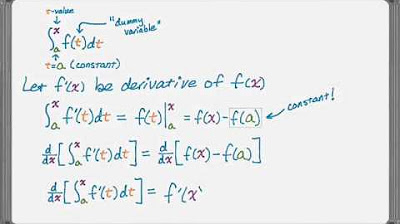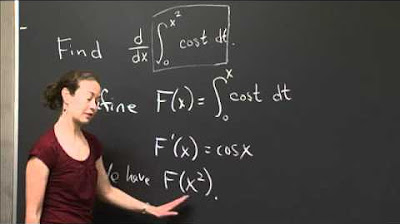Finding derivative with fundamental theorem of calculus: x is on both bounds | Khan Academy
TLDRThe transcript discusses the process of finding the derivative of a function using the Fundamental Theorem of Calculus. It highlights the challenge of dealing with a definite integral where both the upper and lower bounds contain the variable x. The solution involves breaking the integral into two parts using a constant c between x and x squared, applying the theorem to each part, and then combining the results to find the derivative. The final answer is expressed as a simplified expression involving the cosine function and the variable x.
Takeaways
- 📚 The goal is to find the derivative of a given expression, specifically capital F prime of x.
- 🔍 The fundamental theorem of calculus is mentioned as a potential tool to achieve this, but its usual application involves x only on the upper boundary.
- 📈 The challenge is to rearrange the expression to fit the familiar form used when applying the fundamental theorem of calculus.
- 🎨 Visualization through graphing helps to understand the problem better, representing the area under the curve as the definite integral.
- 🔄 By introducing a constant c between x and x squared, the area under the curve can be split into two integrals, simplifying the problem.
- 🌟 The fundamental theorem of calculus can then be applied to each of the two integrals, with the derivative operator yielding negative cosine x over x for the first part.
- 📐 The second part involves taking the derivative of x squared with respect to x, which is 2x, and applying it to the integral.
- 🔢 The final result is a simplified expression combining the two parts: negative cosine of x over x plus 2 cosine of x squared over x.
- 💡 The process demonstrates the power of breaking complex problems into simpler, manageable parts and the application of calculus theorems.
- 📝 The script emphasizes the importance of understanding the structure of the problem and the rules of calculus to solve it correctly.
- 🎓 The explanation serves as a lesson in calculus, showcasing the step-by-step approach to tackling problems involving derivatives and integrals.
Q & A
What is the main objective of the expression discussed in the transcript?
-The main objective is to find the derivative, capital F prime of x, for a given expression using calculus techniques.
What theorem is suggested for use in solving the expression?
-The fundamental theorem of calculus is suggested for use, specifically for taking the derivative of a definite integral that results in a function of x.
Why is the presence of x on both the upper and lower boundary a challenge for applying the fundamental theorem?
-The fundamental theorem of calculus, as typically presented, is applied when x is only on the upper boundary. Having x on both boundaries complicates the direct application of the theorem.
How does the speaker propose to overcome the challenge with the boundaries?
-The speaker suggests introducing a constant c between x and x squared, breaking the area into two different areas which can then be represented as separate integrals, allowing for the application of the fundamental theorem.
What is the significance of graphing the function f(t) over the interval between x and x squared?
-Graphing the function helps in visualizing the area under the curve that the definite integral represents, which is crucial for understanding how to break down the problem and apply calculus theorems.
How does the process of breaking the integral into two parts affect the application of the fundamental theorem?
-By breaking the integral into two parts with a constant c as the lower bound for one and the original lower bound x for the other, the expression can be rewritten in a form that fits the standard application of the fundamental theorem, with x as the upper bound.
What is the result of applying the derivative operator to the rewritten expression?
-Applying the derivative operator results in the expression: negative cosine x over x plus 2 cosine of x squared over x, which simplifies to 2 cosine of x squared minus cosine of x, all over x.
How does the chain rule come into play in this problem?
-The chain rule is used when taking the derivative of the second part of the expression with respect to x squared, where t is replaced with x squared, and the derivative of x squared with respect to x is considered.
What is the final simplified form of the derivative of the given expression?
-The final simplified form of the derivative is (2 cosine of x squared - cosine of x) / x.
What is the significance of the negative sign in the derivative result?
-The negative sign comes from the fact that when applying the fundamental theorem to the rewritten expression, a negative sign is introduced due to the order of the bounds and the nature of the cosine function.
How does this problem illustrate the flexibility of calculus in handling complex expressions?
-This problem demonstrates that by introducing constants and breaking down expressions, calculus can be applied to a wider range of scenarios, including those that don't immediately fit standard theorem applications, showcasing its adaptability and problem-solving power.
Outlines
🤔 Understanding the Derivative of an Integral with Variable Limits
The video script begins by addressing the challenge of taking the derivative of an integral with variable limits, specifically when both the upper and lower limits are functions of x. It highlights a common misconception that the fundamental theorem of calculus applies only when the variable x appears in the upper limit. The narrator then introduces a graphical representation of the function f(t) over the interval between x and x^2 to visualize the problem. By introducing a constant c within this interval, the integral is divided into two parts, allowing for a breakdown that fits the application of the fundamental theorem of calculus. The solution involves applying the chain rule, reversing the limits of integration with a sign change, and ultimately simplifying the expression to find the derivative of the original function. The explanation culminates in a simplified formula for the derivative, showcasing the integration of calculus concepts to solve complex problems.
Mindmap
Keywords
💡derivative
💡fundamental theorem of calculus
💡chain rule
💡definite integral
💡constant
💡area under the curve
💡variable 'x'
💡negative cosine
💡cosine of x squared
💡derivative of x squared with respect to x
💡simplify
Highlights
Introduction to taking the derivative of a definite integral with both upper and lower bounds as functions of x.
Identification of a potential application of the fundamental theorem of calculus despite variable bounds.
Recognition that typical applications of the fundamental theorem involve only the upper boundary varying with x.
Introduction of the chain rule to handle the square of x in the boundary.
Proposal to graph the function within the variable bounds to better understand the integral's representation.
Graphical representation of the function f(t) over the interval between x and x squared.
Breaking the area under the curve into two parts using a constant, to simplify the expression.
Expression of the total area as the sum of two separate integrals over the intervals [x, c] and [c, x^2].
Rearrangement of the integral bounds to fit the conventional form used with the fundamental theorem of calculus.
Application of the fundamental theorem and the chain rule to derive F prime of x.
Derivation of the final expression involving cosine functions and simplification of the result.
Highlighting the importance of understanding and manipulating bounds in integrals for differentiation.
Illustration of the power of graphical interpretation in solving complex calculus problems.
Emphasis on the versatility of the fundamental theorem of calculus when applied with creativity.
Final expression simplification showcasing the subtractive relationship between the integral's bounds.
Transcripts
Browse More Related Video

Derivatives of Integrals (w/ Chain Rule)

Finding derivative with fundamental theorem of calculus: x is on lower bound | Khan Academy

Second Fundamental Theorem of Calculus 2nd FTC

Second fundamental theorem and chain rule | MIT 18.01SC Single Variable Calculus, Fall 2010

Worked example: Finding derivative with fundamental theorem of calculus | Khan Academy

Calculus (Version #2) - 9.1 The Second Fundamental Theorem of Calculus
5.0 / 5 (0 votes)
Thanks for rating: